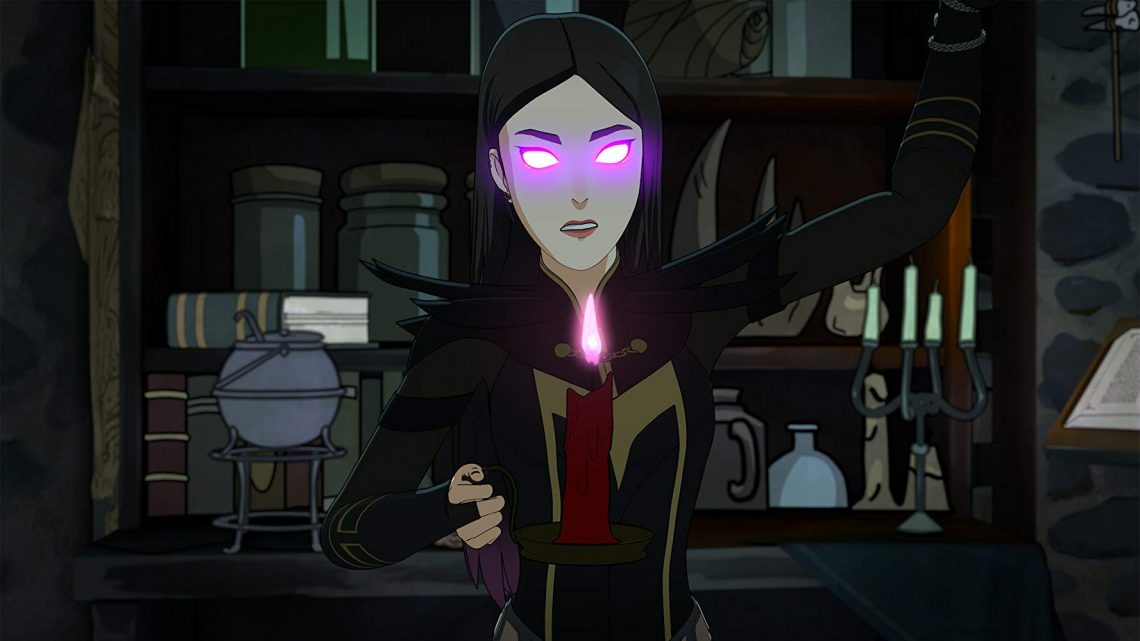
‘The Dragon Prince’ Is What ‘The Last Airbender’ Fans Have Been Waiting For
September 8, 2018The dynamic duo of Aaron Ehasz and Justin Richmond, the minds behind Avatar: The Last Airbender and the Uncharted franchise, respectively, have created what just might be Netflix’s most engrossing original series this fall—and the show The Last Airbender fans have waited ten years to see.
The Dragon Prince is set in the kind of epic, elemental world that will be familiar to anyone who’s seen an episode of The Last Airbender. The land of Xadia is dominated by the six primal sources of magic: the sun, the moon, the stars, the earth, the sky, and the ocean. But humans have invented dark magic, which steals from the essence of magical creatures, and the elves and dragons exile them to the eastern half of the land. When the humans slay the dragon guarding the eastern border and steal its only egg, Xadia is launched into factional war.
“One of our main goals was to make something Avatar fans would love,” Ehasz told me over the phone. Like The Last Airbender, the seasons of The Dragon Prince will be structured in “books” centered around each element. And Jack De Sena, the voice actor for Sokka on The Last Airbender, voices Callum, one of the show’s main characters. Dedicated fans of The Last Airbender will also enjoy the pilot’s nod to “Sokka’s Master,” where a clumsy but dedicated Sokka is trained by a sword-fighting guru.
This isn’t the only comparison the show affords. It calls to mind some of the best works of the high fantasy genre like Lord of the Rings, Harry Potter, or Skyrim. But The Dragon Prince does not come across as being second-hand—the first three episodes deliver a story that is every bit as engaging and complicated as its influences while being satisfyingly different. It delivers in a way few Netflix animated fantasy shows have been able to (Disenchantment, particularly, was a flop).

Xadia is rich and arresting, juxtapositioning the natural world—inhabited by elves, dragons, and other magical creatures—with the man-made world where humans buttress themselves from the consequences of practicing dark magic, which is easier to conjure than regular magic, but inevitably corrosive. “The first idea we had about this whole intellectual property is that there’s a world where there’s arcane magic that’s difficult and you have to learn it and it’s passed on,” Ehasz said. “But someone discovers dark magic where you take the shortcut. What would be the implications of this kind of conflict within this magic system? People using the more exploitative version of things—how would that affect magical creatures and other intelligent beings that are affected by this and who also use magic?”
This idea even appears to have influenced the animation style, which is a blended 2D-3D that feels uneasy at first, but hits its stride as a superb format to showcase the differing styles of magic. (The show seems to have fixed many of the issues that fans had with the trailer, where there was a bit of lag in the animation around dialogue—though it still takes a bit of time to become accustomed to the moments of parallax.)
One of Ehasz’s greatest strengths lies in his characters. The protagonists are Ezram and Callum, the young son and stepson of a king, and Rayla, an elf sent to assassinate him. Their dialogue satisfyingly shifts between quippy and serious, without ever becoming didactic—which would be easy in a world that requires so much exposition.
Nearly every one of the show’s main characters in a child or young adult, which makes the show accessible to younger viewers while not becoming a “children’s show” (another feature of The Last Dragon that The Last Airbender fans will recognize). “It’s not about someone jaded by old patterns of conflict, it’s about becoming adults and whether they’re going to take on those conflicts or think they can change them,” Ehasz said. “We want this to be a real epic fantasy story, for true genre fans. Teens, adults, we want it to be a real experience for them. But we also want it—like Avatar—to have that feeling of it being accessible and appropriate for families and wider audiences as well.”
The characters are at an age where their desire to do what is morally good outweighs nationalism or tribalism. They’re also at an age where their love for their parents might obscure their ability to understand the corrupt motivations behind their parents’ actions. Innocence, acceptance, and redemption become the essential ingredients in motivating Callum, Ezram, and Rayla. “It’s about the younger generation having a chance to come to power, and having to face what has come before them,” Richmond said. “The whole point is that you can change the world. Kids are really, really powerful, they can do lots of amazing things, and at the same it can be a story that’s really grounded and deep.”
Ehasz and Richmond both grew up steeped in the fantasy genre. “It started as early as sleepover parties,” Richmond told me over the phone, “and a lifetime of video games and fantasy novels.” True to fantasy’s origins in both shows and gaming, the showrunners sought to bring together creators from both backgrounds—they’re even developing a video game that would be set in The Dragon Prince’s universe, pending the shows success. “Everyone here is not just a game developer or a writer on the show, but they’re superfans of both sides,” Richmond said, “The teams literally sit back-to-back. For magic, we had our writers and even our CTO sitting down and pitching in ideas of how it could be cooler or better for our gaming experience. We had a lot of cross-pollination there.”
Their lifetime of research has made them committed to making fantasy more inclusive. “So much fantasy is very white, very European,” Richmond told me. “We believe you can tell a cool story about magic, and these creatures, with a diverse cast. And a more diverse audience is something we care about.” Ezran and Callum come from a mixed-race family, and these first episodes take care to explore Callum’s complicated relationship with his racial identity and lineage to the crown without going directly into his backstory. It seems like particularly fertile ground for The Dragon Prince to keep exploring.
In just three episodes, The Dragon Prince demonstrates a mastery of the hallmark strengths of the genre—the melding of world-building and lore with character motivation and progression, where each feels organically in service of the other. And the rest of the season will reveal whether their narrative stands up to the expectation set by these first episodes. “If the audience really buys this, we definitely have a sprawling, epic story in mind that could go on for quite a while longer,” Ehasz said. “You’re in for a ride.”
Sign up for our newsletter to get the best of VICE delivered to your inbox daily.
Follow Nicole Clark on Twitter.


